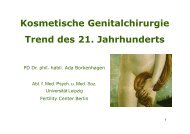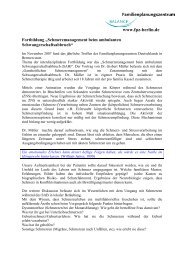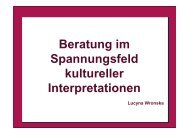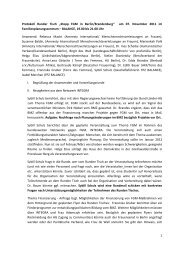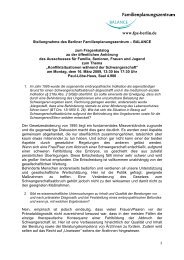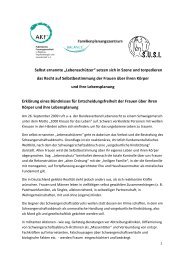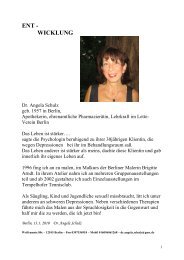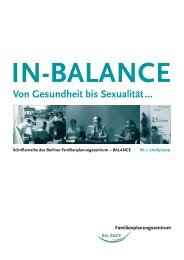Listening to African Voices - FPZ
Listening to African Voices - FPZ
Listening to African Voices - FPZ
Create successful ePaper yourself
Turn your PDF publications into a flip-book with our unique Google optimized e-Paper software.
The two remaining gynaecologists had more substantialinformation <strong>to</strong> provide. One of them was of Eritrean origin.She had for a couple of years run an FGM/C-consultationat the University clinic of Hamburg, and had later workedas a senior physician in the delivery ward of a hospital inHamburg. She confi rmed the fact that some gynaecologistsmight not be able <strong>to</strong> recognise type I and II forms of FGM/Cdue <strong>to</strong> lack of training and the variable physics of the vagina.According <strong>to</strong> her, determining the status was more like apuzzle in which certain signs as well as the country of origincan point <strong>to</strong> a conclusion. She had assisted several womenin the scope of her FGM-consultation hour who camewith urinary tract and vaginal infections as well as sexualproblems. There were also a few cases of infi bulated womenwho were pregnant and needed <strong>to</strong> be advised on how <strong>to</strong>give birth; they either wanted <strong>to</strong> deliver with a C-section orasked <strong>to</strong> be reinfi bulated. The patient had a signifi cant needfor counselling and advice during the FGM/C consultationhour, but the offer for free consultation was terminatedafter a certain period. During her time at the delivery ward,she gathered further experience assisting women who hadundergone FGM/C, notably cases of tearing during childbirththat required closure by suture. She trained the medicalstaff in the hospital on FGM/C and prepared and advisedthe women concerned during their pregnancy.She was also contacted three times by teachers whosuspected that one of their students had been subjected <strong>to</strong>FGM/C over the holidays. All three girls were of Eritreanorigin. Control examinations revealed that the girls had notundergone FGM/C.The second gynaecologist was of German origin and employedby the Familienplannungszentrum [Family PlanningCentre], an institution providing reproductive health care<strong>to</strong> immigrants and other beneficiaries without health carecoverage. There is a strong demand for the institution’s services.It is consulted by about 350 <strong>African</strong> immigrant womenper year, of whom approximately one third have undergoneFGM/C. The women concerned are mainly from West <strong>African</strong>countries, e.g. Cote d’Ivoire, Togo, Nigeria, Benin, BurkinaFaso and Sierra Leone. Despite the high rate of women withFGM/C, they registered only two cases of infibulation. Mostwomen have undergone type I or type II forms and theinstitution has rarely seen complications associated with thepractice. The gynaecologist interviewed estimated that theysituations involving medical complications linked <strong>to</strong> FGM/C,such as extremely rare forms of scarification that hinder theprocess of delivery, are encountered on average once a year.She had never been informed about FGM/C being practiced31 Vice-president of the “Bundesärztekammer” [German MedicalAssociation]in Germany, though she knew there was hearsay that therewere two traditional women practitioners in Berlin.She noted that the women with unclear residence statuswere under heavy pressure <strong>to</strong> remain invisible and <strong>to</strong> gettheir lives in Germany organised. Many of them wish <strong>to</strong> havechildren. Her conclusion was that the women have otherproblems and priorities than FGM/C. She also emphasisedthat the institution had limited time for each patients.Communication problems arise from time <strong>to</strong> time due <strong>to</strong>language barriers. There is not always time <strong>to</strong> build up arelationship of trust with the patients. Her impression of thetraining seminars from the Berufsverband der Frauenärzte[professional association for gynaecologists] was that thereis more focus on demonising the practice than on teachingan appropriate and sensitive approach <strong>to</strong> dealing with thefeelings and needs of the women concerned.Both gynaecologists confirmed the impression that <strong>African</strong>women immigrants usually consulted them only when theywere pregnant or when they had acute symp<strong>to</strong>ms. Preventivecare visits are rare and mostly limited <strong>to</strong> women with ahigh level of education and integration.5.10. Media preferences and information networks ofimmigrant communities from Sub-Saharan Africain HamburgWe asked all key informants what means and places the<strong>African</strong> immigrants use <strong>to</strong> become informed about what isgoing on and which media they use the most. Not a singlekey informant named the German media as a source ofinformation.In terms of media, the key informants stated the followingpreferences:• Internet: When using the internet for informationupdates, many immigrants consult web pages of theircountry of origin such as www.seneweb.com (Senegal),www.icilome.com (Togo), www.ghanaweb.com (Ghana) orwww.abidjan.net for immigrants from Cote d’Ivoire.• Television: Preferred television choices are internationalnews channels (BBC, Al Jazeera, TV5), <strong>African</strong> channels(e.g. Africable) or the national channels of their countriesof origin ( for example RTS for Senegal/Gambia, RTI forCote d’Ivoire).• Radio: As with television, the preferences are either forinternational channels (BBC or RFI) or for Africa-basedradio stations (Africa Nr. 1).The remaining information sources are places of public orprivate gathering. Information is mostly disseminated byword of mouth. Important meeting places are the Afro84<strong>Listening</strong> <strong>to</strong> <strong>African</strong> <strong>Voices</strong>





